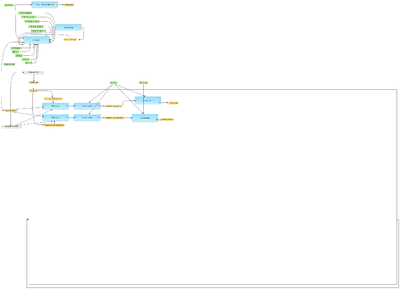Difference between revisions of "Compute differentially expressed genes using EBarrays (workflow)"
(Automatic synchronization with BioUML) |
(Automatic synchronization with BioUML) |
||
| Line 6: | Line 6: | ||
[[File:Compute-differentially-expressed-genes-using-EBarrays-workflow-overview.png|400px]] | [[File:Compute-differentially-expressed-genes-using-EBarrays-workflow-overview.png|400px]] | ||
== Description == | == Description == | ||
| − | This workflow is designed to identify | + | This workflow is designed to identify differentially expressed genes from several experimental conditions applying EBarrays statistics. Normalized data can be generated from Affymetrix ([http://test.genexplain.com/bioumlweb/#de=analyses/Methods/Data normalization/Affymetrix normalization Affymetrix normalization]), Agilent ([http://test.genexplain.com/bioumlweb/#de=analyses/Methods/Data normalization/Agilent normalization Agilent normalization]) or Illumina ([http://test.genexplain.com/bioumlweb/#de=analyses/Methods/Data normalization/Illumina normalization Illumina normalization]) raw data and submitted as input. Please note that the ''EBarray'' method requires two or more replicates for each condition. |
| − | + | The workflow compares up to five conditions / groups in one run. One control group is needed to run this workflow and you need to specify at least two conditions (e.g. "control group" and "disease group"). All possible comparisons between the input groups are calculated in one workflow run. The first step of the workflow is a quality control of the input data and gives out a density boxplot and a density plot. The primary result of the EBarray method is filtered by several conditions in parallel, applying the ''Filter table'' method to identify up- and down-regulated probeset IDs for each comparision. | |
| − | For | + | '''For up-regulated probes: LogFoldChange>0.5 and Sig ==1.''' |
| − | + | '''For down- regulated probes: LogFoldChange<-0.5 and Sig ==1.''' | |
| − | The | + | The tables with filtered up- and down-regulated genes are then annotated with a gene description and a gene symbol. |
| + | |||
| + | The output folder contains gene tables as well as the images of the density boxplots and density plots. | ||
Reference: Kendziorski, C.M., Newton, M.A., Lan, H., Gould, M.N. (2003). On parametric empirical Bayes methods for comparing multiple groups using replicated gene expression profiles. Statistics in Medicine 22:3899-3914. | Reference: Kendziorski, C.M., Newton, M.A., Lan, H., Gould, M.N. (2003). On parametric empirical Bayes methods for comparing multiple groups using replicated gene expression profiles. Statistics in Medicine 22:3899-3914. | ||
| Line 20: | Line 22: | ||
== Parameters == | == Parameters == | ||
;Input table | ;Input table | ||
| − | :Input table with all normalized | + | :Input table with all normalized files |
;Probe type | ;Probe type | ||
;Species | ;Species | ||
Latest revision as of 16:34, 12 March 2019
- Workflow title
- Compute differentially expressed genes using EBarrays
- Provider
- geneXplain GmbH
[edit] Workflow overview
[edit] Description
This workflow is designed to identify differentially expressed genes from several experimental conditions applying EBarrays statistics. Normalized data can be generated from Affymetrix (normalization/Affymetrix normalization Affymetrix normalization), Agilent (normalization/Agilent normalization Agilent normalization) or Illumina (normalization/Illumina normalization Illumina normalization) raw data and submitted as input. Please note that the EBarray method requires two or more replicates for each condition.
The workflow compares up to five conditions / groups in one run. One control group is needed to run this workflow and you need to specify at least two conditions (e.g. "control group" and "disease group"). All possible comparisons between the input groups are calculated in one workflow run. The first step of the workflow is a quality control of the input data and gives out a density boxplot and a density plot. The primary result of the EBarray method is filtered by several conditions in parallel, applying the Filter table method to identify up- and down-regulated probeset IDs for each comparision.
For up-regulated probes: LogFoldChange>0.5 and Sig ==1.
For down- regulated probes: LogFoldChange<-0.5 and Sig ==1.
The tables with filtered up- and down-regulated genes are then annotated with a gene description and a gene symbol.
The output folder contains gene tables as well as the images of the density boxplots and density plots.
Reference: Kendziorski, C.M., Newton, M.A., Lan, H., Gould, M.N. (2003). On parametric empirical Bayes methods for comparing multiple groups using replicated gene expression profiles. Statistics in Medicine 22:3899-3914.
[edit] Parameters
- Input table
- Input table with all normalized files
- Probe type
- Species
- Control group
- Enter control name without spaces
- Control_columns
- Select columns for control
- group_2
- Enter Condition 2 name without spaces
- Columns_group_2
- Select columns for condition 2
- group_3
- Enter Condition 3 name without spaces
- Columns_group_3
- Select columns for condition 3
- group_4
- Enter Condition 4 name without spaces
- Columns_group_4
- Select columns for condition 4
- group_5
- Enter Condition 5 name without spaces
- Columns_group_5
- Select columns for condition 5
- Results folder
